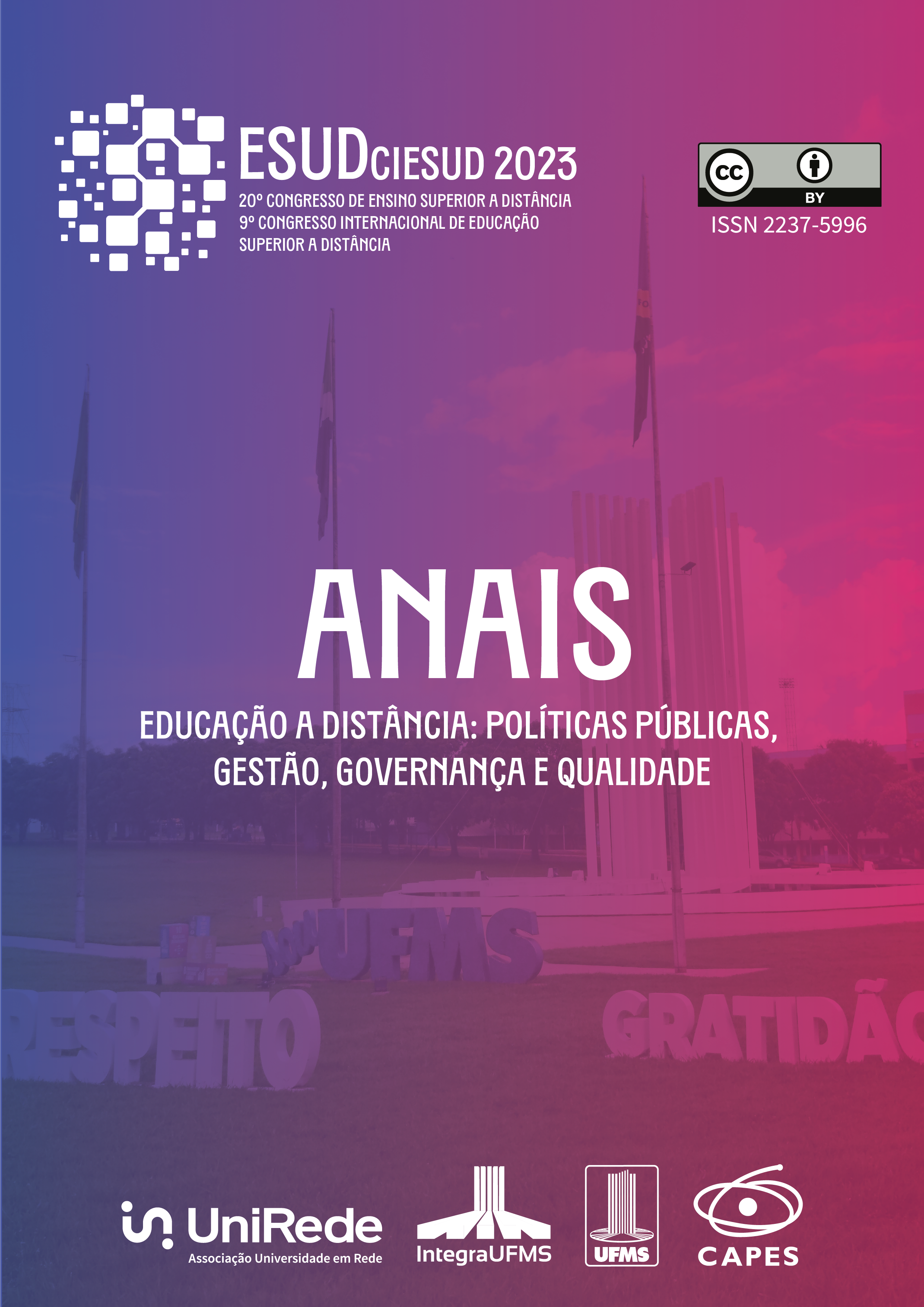READABILITY OF STATEMENTS AND FEEDBACKS OF ACTIVITIES IN A DISTANCE LEARNING COURSE
Keywords:
Evaluation., Graduation., Higher Education.Abstract
The elaboration of statements and the return of the correction of activities is a complex task where several technical and pedagogical criteria must be considered, among them, the level of readability, that is, to know if the writing suits the target audience, and should be analyzed from the statement to its critical-reflective correction, allowing to evaluate with quality the learning and the know-how. Within this context, the objective was to evaluate the level of readability of statements and feedbacks of activities proposed to students of a distance graduation. This is a descriptive research with data collection in the Moodle® Virtual Learning Environment. To this end, notes were cataloged and the analysis of the statements and feedbacks of the activities carried out by tutors in two disciplines, Cell Biology and Introduction to Distance Education offered to 22 students of the Jaguaribe pole, Ceará, was made. In the analysis of the scores of the activities Forum, Concept Map and Infographic, the students obtained an average of 74/100, while in the activities of Dissertation Text, Podcast and Chats the average was 80/100. As for the statements, the activity of the dissertation text presented "very difficult" readingability, being necessary the schooling of Higher Education for its full comprehension. The other statements presented "difficult" readingability, being imperative the schooling of High School. As for the feedbacks of the corrections of these activities, the classification of the activities of the discipline of Introduction to Distance Education was "very difficult" and, for the activities of the discipline of Cell Biology, "difficult". Finally, the data indicate that it is important to consider the level of readability of the statements of the activities at the time of their didactic planning and the feedbacks issued by the tutoring, both should have an alignment with the target audience, aiming to improve the process of evaluation of learning.
References
ALMEIDA, Wallace Carriço de; SANTOS, Edméa Oliveira dos. Formar para Mudar e Não para Acomodar: Pesquisando o Cotidiano e a Cibercultura em Tempos de Pós-Verdade. Revista Docência e Cibercultura, v. 7, n. 2, p. 17-40, 2023.
FERRAZ, Ana Paula do Carmo Marcheti; BELHOT, Renato Vairo. Taxonomia de Bloom: revisão teórica e apresentação das adequações do instrumento para definição de objetivos instrucionais. Gest. Prod., São Carlos, v. 17, n. 2, p. 421-431, 2010.
JESUS, Lucas Müller. Motion graphic design como ferramenta de educação a distância em libras. 97 f. Dissertação de Mestrado. Programa de Pós-Graduação em design e expressão gráfica. Universidade Federal de Santa Catarina: Florianópolis, SC, 2013.
LEMOS, Alessandra. A importância da comunicação escrita no ambiente corporativo. Informe CAPESESP. v. 8, 2019.
MARCONI, Marina de Andrade; LAKATOS, Eva Maria. Metodologia científica. 4. ed. São Paulo: Ed. Atlas, 2004.
McLAUGHLIN, G. Harry. SMOG grading: a new readability formula. Journal of Reading, v. 12, p. 639-646, 1969.
MLIS, Nancy Adams. Bloom’s taxonomy of cognitive learning objectives. J Med Libr Assoc, [s.I], v. 10, n. 3, 2015.
MOUTINHO, Michell; PICANÇO, Gessiane. Índices de leiturabilidade e os textos didáticos: uma questão a ser discutida. Revista Virtual Lingu@ Nostr@, v. 10, n. 2, p. 124-147, 2022.
PAIXÃO, Germana Costa; ARARIPE, Fátima Aurilane de Aguiar Lima; VIDAL, Eloisa Maia. (Re)criando atividades pedagógicas com tecnologias digitais: uma contribuição para cursos EaD. Fortaleza: EdUECE, 2022.
PONOMARENKO, Gabriel Luciano; EVERS, Aline. Leiturabilidade e Ensino: Autores-Base e seus Trabalhos. In: Acessibilidade textual e terminológica [ FINATTO; Maria José Bocorny; PARAGUASSU, Liana Braga. (org.) - Uberlândia: EDUFU, 2022.
VALÉRIO, Miguel Angelo. Violência doméstica: usar a leiturabilidade para (bem) informar. Investigação e Debate, v. 18, n. 1, p. 35-47, 2009.
Downloads
Published
How to Cite
Issue
Section
License
Copyright (c) 2024 Lydia Dayanne Maia Pantoja, Laura Helena Pinto de Castro, Germana Costa Paixão

This work is licensed under a Creative Commons Attribution 4.0 International License.
The event uses the Creative Commons License - Attribution 4.0 International as a basis. It believes in the importance of the open access movement in scientific journals, such as the Open Archives Initiative.
By submitting a text to the event, the authors agree to the following terms:
- The authors agree to license works accepted for publication under the Creative Commons License - Attribution 4.0 International.
- With CC-BY 4.0 licensing, authors maintain intellectual rights over the text and grant the event the right to first publication.
- The authors authorize the sending and indexing of texts written by them in databases and academic and scientific information portals.
- Authors are allowed and encouraged to publish and distribute their work online, in institutional repositories, on personal pages and academic social networks, after the editorial process, as long as the forms of licensing and presentation of the text are respected, in addition to the indication of the place of origin of the publication, in this case, the link to the event publishing system.
- The authors of the works published in the event are expressly responsible for their content.
- All works submitted to the event that have images, photographs, figures in which images of human beings are registered in their bodies must be accompanied by an Image Use Authorization Term by the member participating in the image and, in the case of children, family members of exposed children, with data and signature.





